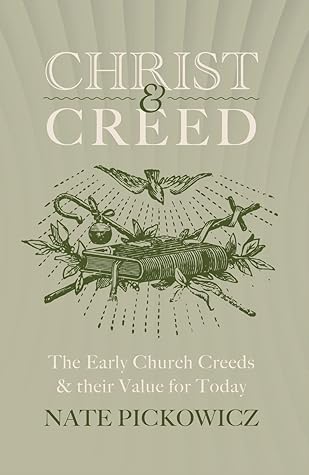Kindle Notes & Highlights
Read between
November 10 - November 10, 2023
But what the Reformers were not advocating was a total rejection of all extra-biblical teaching.
Sadly, many believers live their entire lives completely disconnected from the rich Christian heritage and helpful blessings of such treasures.
‘represent a public statement of what a particular church or denomination believes that Scripture teaches in a synthetic form.’
‘a form of words setting forth with authority certain articles of belief, which are regarded by the framers as necessary for salvation, or at least for the well-being of the Christian Church.’
I am inclined to believe, therefore, that the issue is not as much with offering up written statements of belief as it is rejecting the perception that somehow the man-made documents handed down to us through church history are an affront to our firm belief in the supremacy of the Word of God.
The general consensus is that the creed was derived from the Old Roman Creed (c. A.D. 140) that was recited during baptisms.4
Justin Holcomb goes a step further, noting, ‘Catholic’ means the church exists in every nation where the gospel has spread,’ citing the words of Ignatius of Antioch: ‘wherever Jesus Christ is, there is the Catholic Church.’
In echoing the theological consensus of Christian scholars worldwide, Lewis Ayres has noted that the Nicene Creed is ‘the most important creed in the history of Christianity.’
Basil of Caesarea, Gregory of Nazianzus, and Gregory of Nyssa.
Apollinaris espoused the view that Jesus Christ was truly divine but not truly human. While he taught that Christ did have a human body, he maintained that He did not have a human mind, since the human mind is the origin of all sinful thoughts. He reasoned that were Christ to have a human mind, He could not maintain sinlessness.
‘What has not been taken up has not been healed.’
One of the challenges that arose in the wake of Nicaea was the confusion between the usage of two words: ousia and hypostasis. In the Greek language, the words are virtually synonymous, having to do with the ‘substance,’ or essence, and personhood of God.17 The Cappadocian fathers reconciled this difference by using the word ousia to refer to the divine essence, of which the Father and Son (as well as the Spirit) partake fully and equally, making the three persons one God. When using the word hypostasis, however, they employed it to refer to the distinct form (personhood) in which the divine
...more
how can Jesus Christ be at the same time God and man?
literalistic
allegorical
Nestorius brought the distinction too far, espousing the view that there are essentially two distinct persons—
In this way, Nestorius taught that Jesus was merely an especially graced human man with whom the divine Son of God had united Himself.2 However, this is not how Scripture presents, or the church had understood, the incarnation of Jesus Christ.
They agreed instead to compose a ‘definition’ that would further explain Nicaea’s doctrine of Christ. While the final document consisted of several pages, there was one succinct paragraph about the Son of God, which is now known as the Definition of Chalcedon.
Theologians refer to this concept as the eternal generation of the Son, meaning that, while the Son is begotten from the Father, He is begotten eternally, and therefore has no beginning. This eternality is expressed by the phrase ‘before the ages.’ Jesus has always been truly God, of the same divine substance as the Father.
But these were targeted efforts to root out heresies; they were not blueprints to overhaul the whole religious system. By the time of the Protestant Reformation, the religious leaders throughout Europe began writing treatises and drafting doctrinal confessions in order to re-establish the bounds of biblical orthodoxy moving forward.
Whereas a creed is a short summary statement of essential doctrine, confessions offer an expanded view of theology applied to all aspects of religious life and practice. Over
Adapted from the Westminster Confession of Faith (1647) and the Savoy Declaration (1658), the confession seeks to expound Reformed doctrine yet offers significant modification of previous statements with regard to the doctrine of the church and the sacraments, especially baptism.
each having the whole Divine Essence, yet the Essence undivided,
And while modern sensibilities tend to spurn the things that are deemed to be ‘old’ there can be no escaping the truth that the early church creeds lay the foundation of essential orthodoxy, of which the cornerstone is none other than the Word of God.
So, why are they seemingly absent from the modern Christian landscape?
We are living in a cultural moment where there are so many churches that talk incessantly about Jesus Christ yet seem to say very little about him.
They believed that by rejecting this doctrine they were returning to a ‘primitive’ form of Christianity that was truer to its original founding. This book has gone to great lengths to argue that both the Bible and the witness of the historical church affirm Trinitarian theology.
One of the more present and insidious affronts to orthodox Trinitarianism today is the prevalence of Oneness Pentecostalism. Emerging only in the last century, Oneness Pentecostalism (also known as the Jesus Only Movement) teaches the view that there is one God who manifests Himself in different modes at different times. This modern movement is essentially a dressed-up iteration of the Modalistic Monarchianism of the third century. However, this movement is continuing to grow in popularity, especially in charismatic circles. Yet it poses a substantial threat to knowing the true and living God,
...more


